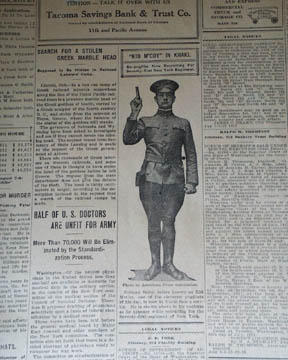Benjamin Harrison was president of the United States when the first issue of this newspaper appeared on this date 113 years ago.
It was The Gilded Age in this country when the newspaper that is today known as the Tacoma Daily Index was born – a time when American society could best be described as outwardly showy but inwardly corrupt during the industrialization of the late 1800s.
It was only the year before, in 1889, that the territory of Washington was admitted to the union as a state.
As for the Tacoma of 1890, it was a rough-hewn city of 36,000 people. It was a time of rapid growth and development for Tacoma, the city having a number of years earlier been designated the western terminus by Northern Pacific Railroad.
Sailing ships came to Tacoma, and with forests thick with virgin timber, the Weyerhaeuser Timber Company was a decade or so away from becoming a major economic force in the city.
By 1892, Tacomas population had swelled to 50,000.
The first issue of this newspaper appeared on May 1, 1890 as a single sheet under the name of Daily Mortgage and Lien Record.
That same year, the name was changed to the Daily Court and Commercial Index.
Around 1915, the name was changed once more to the present Tacoma Daily Index.
One of the oldest newspapers in the state, the Index has had relatively few owners.
R.B. Whitaker was the newspapers first publisher. He sold the publication to Herbert Johnson in 1914, with Johnson continuing as publisher until his death in 1931. That year, Victor Hedberg and J.D. Ogden purchased the newspaper.
Marshall Skidmore purchased Ogdens interest in the newspaper in 1961, becoming the sole owner following Hedbergs retirement in 1969.
Sound Publishing, Inc. purchased the newspaper from Skidmore in 1997 and is the current owner.
Much has changed since the Index was conceived. Tacoma is now one of the Northwests leading cities, with a population of nearly 200,000 people, making it arguably the second largest city in the state.
Tacoma is a lot less rural than it was back then, embracing technology as Americas #1 Wired City.
Still, the more things change, the more they stay the same, as once again the city is experiencing growth, with downtown Tacomas recent economic development and cultural renaissance.
A specialized business and legal newspaper, with the bulk of the publications contents being calls for public bids, permit and other public records, contractor listings and advertisements, the Index of the 1890s is similar to the Index of today.
Today the newspaper sports a Website, e-mailed legal notices and computerized production – all things unimaginable in 1890.
Still, the mission of the Tacoma Daily Index remains essentially unchanged from 113 years ago – to deliver timely information useful to those in the business community.
The publisher and staff thank you for your support and look forward to continuing to serve you.
WHAT ELSE HAPPENED IN 1890?
– William II became Kaiser of Germany and dismissed Chancellor Otto von Bismarck, thus ending the career of the man who was responsible for the unification of Germany.
– The Eiffel Tower in Paris, France was completed.
– Dutch painter Vincent Van Gogh committed suicide. During his lifetime he sold only one painting, becoming successful only upon death.
– The McKinley Tariff, the highest tariff in American history to date, was passed. It called for a tariff of over 49.5 percent on most goods.
– Idaho and Wyoming became the 43rd and 44th states, respectively, to join the United States.
– Convicted murderer William Kemmler became the first person to be executed in the electric chair, as he was put to death at Auburn State Prison in New York. The electric chair was introduced in New York City.
– Also in New York, the first moving-picture shows began to appear.
– Sioux Indian Chief Sitting Bull and 11 other tribe members were killed in Grand River, S.D., during a fracas with Indian police. This eventually led to the last major conflict of the Indian wars, the so-called massacre at Wounded Knee Creek, S.D., where troops from the U.S. 7th Cavalry killed several hundred Sioux.





